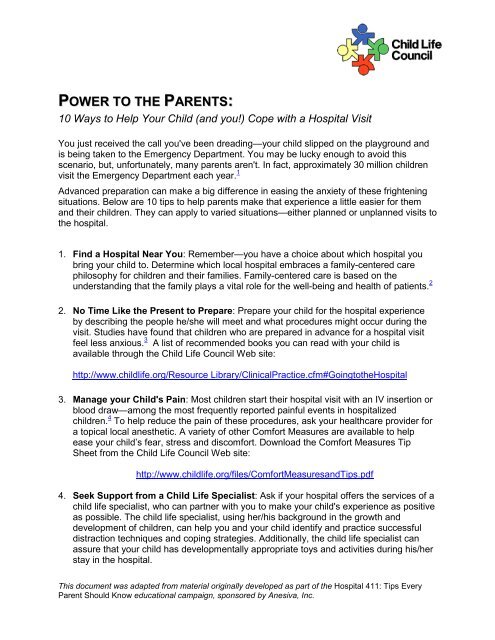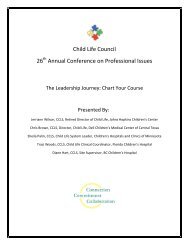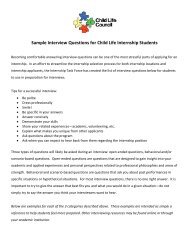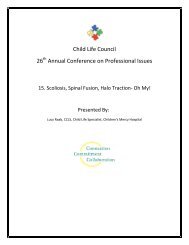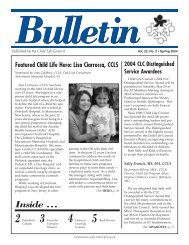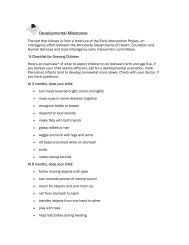Power to the Parents Tip Sheet - Child Life Council
Power to the Parents Tip Sheet - Child Life Council
Power to the Parents Tip Sheet - Child Life Council
You also want an ePaper? Increase the reach of your titles
YUMPU automatically turns print PDFs into web optimized ePapers that Google loves.
POWER TO THE PARENTS:<br />
10 Ways <strong>to</strong> Help Your <strong>Child</strong> (and you!) Cope with a Hospital Visit<br />
You just received <strong>the</strong> call you've been dreading—your child slipped on <strong>the</strong> playground and<br />
is being taken <strong>to</strong> <strong>the</strong> Emergency Department. You may be lucky enough <strong>to</strong> avoid this<br />
scenario, but, unfortunately, many parents aren't. In fact, approximately 30 million children<br />
visit <strong>the</strong> Emergency Department each year. 1<br />
Advanced preparation can make a big difference in easing <strong>the</strong> anxiety of <strong>the</strong>se frightening<br />
situations. Below are 10 tips <strong>to</strong> help parents make that experience a little easier for <strong>the</strong>m<br />
and <strong>the</strong>ir children. They can apply <strong>to</strong> varied situations—ei<strong>the</strong>r planned or unplanned visits <strong>to</strong><br />
<strong>the</strong> hospital.<br />
1. Find a Hospital Near You: Remember—you have a choice about which hospital you<br />
bring your child <strong>to</strong>. Determine which local hospital embraces a family-centered care<br />
philosophy for children and <strong>the</strong>ir families. Family-centered care is based on <strong>the</strong><br />
understanding that <strong>the</strong> family plays a vital role for <strong>the</strong> well-being and health of patients. 2<br />
2. No Time Like <strong>the</strong> Present <strong>to</strong> Prepare: Prepare your child for <strong>the</strong> hospital experience<br />
by describing <strong>the</strong> people he/she will meet and what procedures might occur during <strong>the</strong><br />
visit. Studies have found that children who are prepared in advance for a hospital visit<br />
feel less anxious. 3 A list of recommended books you can read with your child is<br />
available through <strong>the</strong> <strong>Child</strong> <strong>Life</strong> <strong>Council</strong> Web site:<br />
http://www.childlife.org/Resource Library/ClinicalPractice.cfm#Going<strong>to</strong><strong>the</strong>Hospital<br />
3. Manage your <strong>Child</strong>'s Pain: Most children start <strong>the</strong>ir hospital visit with an IV insertion or<br />
blood draw—among <strong>the</strong> most frequently reported painful events in hospitalized<br />
children. 4 To help reduce <strong>the</strong> pain of <strong>the</strong>se procedures, ask your healthcare provider for<br />
a <strong>to</strong>pical local anes<strong>the</strong>tic. A variety of o<strong>the</strong>r Comfort Measures are available <strong>to</strong> help<br />
ease your child’s fear, stress and discomfort. Download <strong>the</strong> Comfort Measures <strong>Tip</strong><br />
<strong>Sheet</strong> from <strong>the</strong> <strong>Child</strong> <strong>Life</strong> <strong>Council</strong> Web site:<br />
http://www.childlife.org/files/ComfortMeasuresand<strong>Tip</strong>s.pdf<br />
4. Seek Support from a <strong>Child</strong> <strong>Life</strong> Specialist: Ask if your hospital offers <strong>the</strong> services of a<br />
child life specialist, who can partner with you <strong>to</strong> make your child's experience as positive<br />
as possible. The child life specialist, using her/his background in <strong>the</strong> growth and<br />
development of children, can help you and your child identify and practice successful<br />
distraction techniques and coping strategies. Additionally, <strong>the</strong> child life specialist can<br />
assure that your child has developmentally appropriate <strong>to</strong>ys and activities during his/her<br />
stay in <strong>the</strong> hospital.<br />
This document was adapted from material originally developed as part of <strong>the</strong> Hospital 411: <strong>Tip</strong>s Every<br />
Parent Should Know educational campaign, sponsored by Anesiva, Inc.
5. Stay Calm, Cool and Collected: Your child will look <strong>to</strong> you for support during this scary<br />
time, so it is important <strong>to</strong> remain calm. If you are calm, your child is less likely <strong>to</strong> feel<br />
anxious. 2<br />
6. Your Questions Matter—Speak Up!: Ask questions, take notes and don't be afraid <strong>to</strong><br />
speak up if you don't understand something. You have <strong>the</strong> right <strong>to</strong> understand what is<br />
happening <strong>to</strong> your child so you can make informed decisions about his/her care.<br />
7. Pack A Favorite Toy or Activity: Bring 1–2 of your child's favorite comfort items <strong>to</strong> use<br />
while you are waiting (e.g., favorite blanket, stuffed animal, book or video game). Having<br />
familiar items will help your child feel safe and ease anxiety.<br />
8. Provide Medical His<strong>to</strong>ry: Keep a detailed record of your child's medical his<strong>to</strong>ry in your<br />
wallet so that you're always prepared. This should include blood type, allergies, current<br />
medications, insurance and pediatrician information, previous injuries or<br />
hospitalizations. Download and complete a cus<strong>to</strong>mizable Wallet Card <strong>to</strong> carry with you<br />
at all times:<br />
http://www.childlife.org/files/HospitalWalletCard.pdf<br />
9. Honesty is <strong>the</strong> Best Policy: Be honest with your child about what is happening. If a<br />
procedure may be uncomfortable, prepare <strong>the</strong> child for it, but remember, children<br />
experience discomfort and/or pain in various ways. No matter what, your child will<br />
benefit from your presence and support.<br />
10. Praise Goes a Long Way: Offer support and encouragement throughout <strong>the</strong> hospital<br />
process. For example, if your child has an x-ray, praise him/her for lying so still.<br />
Acknowledge your child’s fear and support him/her for taking steps <strong>to</strong> overcome it.<br />
References<br />
1. Committee on <strong>the</strong> Future of Emergency Care in <strong>the</strong> United States Health System; Institute of<br />
Medicine. Emergency Care for <strong>Child</strong>ren: Growing Pains. Future of Emergency Care series.<br />
The National Academies Press: Washing<strong>to</strong>n, D.C., 2006.<br />
2. <strong>Child</strong>ren's Hospital of Los Angeles: Principles of Family Centered Care;<br />
http://www.childrenshospitalla.org/site/pp.aspxc=ipINKTOAJsG&b=3897213&printmode=1.<br />
Accessed July 7, 2008.<br />
3. Schechter NL, Zempsky WT, Cohen LL, et al. Pain Reduction During Pediatric<br />
Immunizations: Evidence-Based Review and Recommendations. Pediatrics<br />
2007;119;e1184-e1198.<br />
4. Wong DL and Baker CM. Pain in <strong>Child</strong>ren: Comparison of Assessment Scales. Pediatric<br />
Nursing. 1988;14:9-17.<br />
This document was adapted from material originally developed as part of <strong>the</strong> Hospital 411: <strong>Tip</strong>s Every<br />
Parent Should Know educational campaign, sponsored by Anesiva, Inc.


